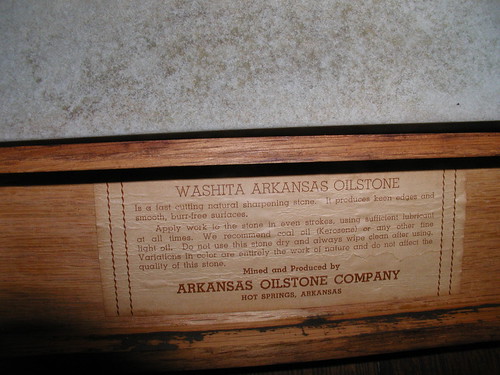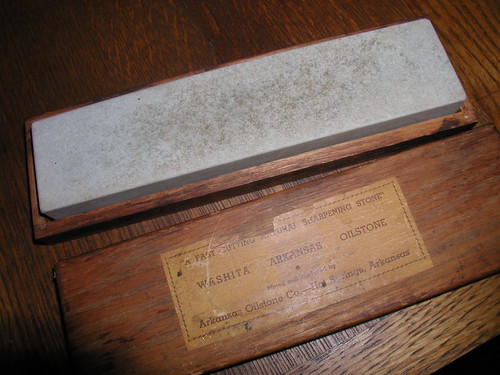Here's a follow-up post to
my one above, and I'm afraid it will be based even more on conjecture and hunch than the previous.
A question that's the basis of some of the conversation on this thread and elsewhere, is this:
And the old survey lists more mines, it's a tangled mess for me. More mines than manufactures for sure and at times hard to say if they where mining arks or washita's.
To what extent can we consider Washitas and Soft Arkansas stones as being the same thing? Can any strict differentiation actually be made?
The whetstone quarries of Hot Springs are all found in together in quite a small geographical area, and they’re all pulling the same type of rock - novaculite - out of the ground. But geological formations don’t happen in neat, well-defined boxes, so that millions of years later someone can put a label on a sharpening stone and sell it as one thing or the other. They happen on a spectrum.
---
Let's start by looking at a couple of interesting stones owned by members on B&B. These are both labelled Pike Soft Arkansas, the first is notably quite translucent with a SG of 2.55, the second I don't know but I'd guess a little less:
Now a labelled Pike Lily White of mine, also fairly translucent, though the SG is lower at 2.36. This is admittedly quite an unusual Washita, but visually these three stones are peas in a pod, the pores and patterns on the surface are strikingly similar:
---
So why are Pike selling stones that I would bet my bottom dollar are the same, as two different things?
The charitable answer might be that they too recognise the blurred lines of definition in geological formations, but use their years of expertise and experience to evaluate hardness, porosity and specific gravity, in order to determine what stones are Washitas, and what are Soft Arkansas.
The less charitable answer though might recognise that Pike were undeniably superb at reading and dictating the market for their products. And that in the late 19th Century had bought a number (all?) of the old Washita quarries, as well as George Reynolds - probably the only other company who were producing them. And so frankly Pike could sell whatever they want, as whatever they want, depending on what they thought might make the most money.
Here’s a very interesting 19th century advertisement for Pike oilstones:
I’ve posted that page before here, but until now I hadn’t noticed that Soft Arkansas stones are conspicuous in their absence. Though by 1905 a Pike pamphlet
does mention them, and notes they 'generally sell at about one-third less price than Hard Arkansas‘. Which still makes them just a little bit more expensive than even Lily White or Rosy Red Washitas. Could it be that the entire idea of a ‘Soft Arkansas’ whetstone was simply an invention of Pike’s, after acquiring the Sutton quarries, in order to ride on the coat tails of the high prices and demand for ‘Hard Arkansas’ stones?*
At the end of my post above is a lineup pic of the old Washitas I have atm, which were all found in either the UK or Aus:
I have no doubt that all of these stones were originally sold as 'Washitas'; the name had considerable cachet and market recognition in the UK, and it is still far more common to find old Washitas in the UK than it is in the US. But might the same stones have been sold as something else back in the states?
I don't know the answer to these questions. This is all speculation.
---
I received an exciting delivery today, this is the first labelled Soft Arkansas stone I have ever had or used:
Can you guess why I bought it? Pretty huh! The 'holder' there actually turned out to be the top of the box, and it told me that this is soft ark produced by:
Global recognition no less! Colour me tantalised...**
So obviously I'm going to compare it some Washitas. Just to emphasise - this
isn't a new stone that has been sold as a Washita - it's positioning itself firmly in the Soft Ark camp. It's also a sample size of one, so we're not in particularly scientific territory here. Nevertheless I'm interested to see how deep the familial resemblance runs, especially as I said, because this is the first time I've used a Soft Ark. These stones are arranged in descending order of specific gravity, and when I measured them today the LW and No.1 actually surprised me a little, as in my mind they were both a bit higher, but there you go.
L to R: Pike Lily White (2.36), Washita (2.30), Pike-Norton No.1 (2.10), Natural Hones Soft Ark (2.09), Washita (2.08):
Obviously here I've chosen Washitas 3 and 5 because they have almost identical SG readings to the Soft Ark, so if the distinction is as blurry as some of what I've said above might suggest, then we should be able to see a fairly strong similarity between them. Washitas 1 and 2 I've chosen because their SG is at the higher end of the scale - to see if the soft ark is more similar to the low SG Washitas, than they are to the higher ones.
---
Well first up - the Soft Ark is noticeably softer than a Washita, it takes no time at all to lap. When done the surface feels similar-ish, though slightly grittier, sandier. I'm actually a little surprised it's as different as it is.
Washita 1 (Pike LW) is a very fine example, it works quite fast for a fine stone, but it doesn’t have a big range. It doesn’t do super-quick and coarse metal removal like more typical examples.
Washita 2 (which I found at the weekend here is Aus) is a
superb stone. With noticeably larger, more visible pores than the first. This stone has a big range and is seriously fast with pressure. Right up there with my favourite Washitas I've had.
Washita 3 (P-N No.1) is a very good stone also, it has quite a large range though not as fast as the above. Finishes surprisingly fine considering the SG.
The NHI Soft Ark (4) is quite clearly a different stone from the Washitas. It feels as much like a Hindostan as it does a Washita. It's a very fast stone, and slurries quite heavily in almost no time, but doesn't finish nearly as fine as the Washitas. Overall it’s not a million miles away in terms of use, but there’s no way you’d confuse them. In a funny way this stone feels most similar to Washita 2, which I think is a very old stone.
Washita 5 is very similar to 3, though it’s a little coarser. 3 and 5 I would consider as quite typical Norton era Washitas. Very nice stone.
---
I don't know if or what any of that might say. Except that there are some Soft Arks that are notably different from old Washitas. This stone is considerably softer than the Washitas with an identical SG, and a lot of its speed is coming from slurry. But it's similar enough to bear comparison.
There is certainly something special about old Washitas, but it’s by no means inconceivable that other quarries and companies apart from P-N have at some point dug up the same kind stone. So I can't really conclude anything more revolutionary than saying that I think a Washita is a hard version of a soft ark. Or a porous version of a hard ark. And how and where those distinctions are drawn probably just depends on who's cutting it up, and putting it in neat boxes.
---
* I could probably get a better idea of whether this possibility has any legs or not by reading through Griswold again. I may do that later...
** Anyone heard of this company? Considering the breadth of their alleged market penetration they have curiously little interenet presence...




















